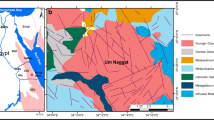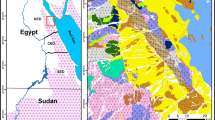Abstract
Structural maps are traditionally produced by mapping features such as faults, folds, fabrics, fractures and joints in the field. However, large map areas and the spatially limited ground perspective of the field geologist can potentially increase the likelihood that not all structural features will be identified within a given area. The ability to recognise and map both local and regional structural features using high-resolution remote sensing data provides an opportunity to complement field-based mapping to help generate more comprehensive structural maps. Nonetheless, vegetation cover can adversely affect the extraction of structural information from remotely sensed data as it can mask the appearance of subtle spectral and geomorphological features that correspond to geological structures. This study investigates the utility of airborne Light Detection And Ranging (LiDAR) data and airborne multispectral imagery for detailed structural mapping in vegetated ophiolitic rocks and sedimentary cover of a section of the northern Troodos ophiolite, Cyprus. Visual enhancement techniques were applied to a 4-m airborne LiDAR digital terrain model and 4-m airborne multispectral imagery to assist the generation of structural lineament maps. Despite widespread vegetation cover, dykes and faults were recognisable as lineaments in both data sets, and the predominant strike trends of lineaments in all resulting maps were found to be in agreement with field-based structural data. Interestingly, prior to fieldwork, most lineaments were assumed to be faults, but were ground-verified as dykes instead, emphasising the importance of ground-truthing. Dyke and fault trends documented in this study define a pervasive structural fabric in the upper Troodos ophiolite that reflects the original sea-floor spreading history in the Larnaca graben. This structural fabric has not previously been observed in such detail and is likely to be continuous in adjacent regions under sedimentary cover. This information may be useful to future exploration efforts in the region focused on identification of structurally controlled mineral and groundwater resources. Overall, our case study highlights the efficacy of airborne LiDAR data and airborne multispectral imagery for extracting detailed and accurate structural information in hard-rock terrain to help complement field-based mapping.









Similar content being viewed by others
References
Ali SA, Pirasteh S (2004) Geological applications of landsat enhanced thematic mapper (ETM) data and geographic information system (GIS): mapping and structural interpretation in south-west Iran, Zagros structural belt. Int J Remote Sens 25:4715–4727
Argialas DP, Mavrantza OD (2004) Comparison of edge detection and Hough transform techniques for the extraction of geologic features. Int Arch Photogramm Remote Sens Spat Inf Sci 34:790–795
Arrowsmith JR, Zielke O (2009) Tectonic geomorphology of the San Andreas Fault zone from high resolution topography: an example from the Cholame segment. Geomorphology 113:70–81
Axelsson P (2000) DEM generation from laser scanner data using adaptive TIN models. Int Arch Photogramm Remote Sens 33:110–117
Barnes JW, Lisle RJ (2004) Basic geological mapping, 4th edn. Wiley, Chichester
Bear LM (1960) The geology and mineral resources of the Akaki-Lythrodondha area, Memoir 3. Geological Survey Department, Cyprus
Boyle JF, Robertson AHF (1984) Evolving metallogenesis at the Troodos spreading axis. Geol Soc Lon Spec Publ 13:169–181
Corgne S, Magagi R, Yergeau M, Sylla D (2010) An integrated approach to hydro-geological lineament mapping of a semi-arid region of West Africa using Radarsat-1 and GIS. Remote Sens Environ 114:1863–1875
Cunningham D, Grebby S, Tansey K, Gosar A, Kastelic V (2006) Application of airborne LiDAR to mapping seismogenic faults in forested mountainous terrain, southeastern Alps, Slovenia. Geophys Res Lett 33:L20308
Fitton NC, Cox SJD (1998) Optimising the application of the Hough transform for automatic feature extraction from geoscientific images. Comput Geosci 24:933–951
Gass IG (1960) The geology and mineral resources of the Dhali area, Memoir 4. Geological Survey Department, Cyprus
Gass IG (1968) Is the Troodos massif of Cyprus a fragment of Mesozoic ocean crust? Nature 220:39–42
Grebby S, Cunningham D, Naden J, Tansey K (2010) Lithological mapping of the Troodos ophiolite, Cyprus, using airborne LiDAR topographic data. Remote Sens Environ 114:713–724
Grebby S, Naden J, Cunningham D, Tansey K (2011) Integrating airborne multispectral imagery and airborne LiDAR data for enhanced lithological mapping in vegetated terrain. Remote Sens Environ 115:214–226
Harding DJ, Berghoff GS (2000) Fault scarp detection beneath dense vegetation cover: airborne lidar mapping of the Seattle fault zone, Bainbridge Island, Washington State. In: Proceedings of the American society of photogrammetry and remote sensing annual conference, Washington, DC, May 2000. American Society of Photogrammetry and Remote Sensing, Bethesda, Maryland
Haugerud RA, Harding DJ, Johnson SY, Harless JL, Weaver CS, Sherrod BL (2003) High-resolution Lidar topography of the Puget Lowland, Washington—A bonanza for earth science. GSA Today 13:4–10
Hill RA, Wilson AK, George M, Hinsley SA (2010) Mapping tree species in temperate deciduous woodland using time-series multi-spectral data. Appl Veg Sci 13:86–99
Jensen JR (2005) Introductory digital image processing: a remote sensing perspective. Prentice Hall, New Jersey
Jordan G, Schott B (2005) Application of wavelet analysis to the study of spatial pattern of morphotectonic lineaments in digital terrain models. A case study. Remote Sens Environ 94:31–38
Karnieli A, Meisels A, Fisher L, Arkin Y (1996) Automatic extraction and evaluation of geological linear features from digital remote sensing data using a Hough transform. Photogramm Eng Remote Sens 62:525–531
Koike K, Nagano S, Ohmi M (1995) Lineament analysis of satellite images using a segment tracing algorithm (STA). Comput Geosci 21:1091–1104
Koike K, Nagano S, Kawaba K (1998) Construction and analysis of interpreted fracture planes through combination of satellite-image derived lineaments and digital elevation model data. Comput Geosci 24:573–583
Kraus K, Pfeifer N (1998) Determination of terrain models in wooded areas with airborne laser scanner data. ISPRS J Photogramm Remote Sens 53:193–203
Kresic N (1995) Remote sensing of tectonic fabric controlling groundwater flow in Dinaric Karst. Remote Sens Environ 53:85–90
Masoud A, Koike K (2006) Tectonic architecture through Landsat-7 ETM+/SRTM DEM-derived lineaments and relationship to the hydrogeologic setting in Siwa region, NW Egypt. J Afr Earth Sci 45:467–477
Moore GK, Waltz FA (1983) Objective procedures for lineament enhancement and extraction. Photogramm Eng Remote Sens 49:641–647
Moores EM, Vine FJ (1971) Troodos Massif, Cyprus and other ophiolites as oceanic crust: evaluation and implications. Philos Trans R Soc A 268:443–467
Mountrakis D, Pavlides S, Zouros N, Astaras T, Chatzipetros A (1998) Seismic fault geometry and kinematics of the 13 May 1995 Western Macedonia (Greece) earthquake. J Geodyn 26:175–196
Nyborg M, Berglund J, Triumf C-A (2007) Detection of lineaments using airborne laser scanning technology: Laxemar-Simpevarp, Sweden. Hydrogeol J 15:29–32
O’Leary DW, Friedman JD, Pohn HA (1976) Lineament, linear, lineation—some proposed new standards for old terms. Geol Soc Am Bull 87:1463–1469
Parsons AJ, Yearley RJ (1986) An analysis of geologic lineaments seen on LANDSAT MSS imagery. Int J Remote Sens 7:1773–1782
Pavlis TL, Bruhn RL (2011) Application of LIDAR to resolving bedrock structure in areas of poor exposure: an example from the STEEP study area, southern Alaska. Geol Soc Am Bull 123:206–217
Peña SA, Abdelsalam MG (2006) Orbital remote sensing for geological mapping in southern Tunisia: implication for oil and gas exploration. J Afr Earth Sci 44:203–219
Prentice CS, Crosby CJ, Harding DJ, Haugerud RA, Merritts DJ, Gardner TW, Koehler RD, Baldwin JN (2003) Northern California LIDAR data: a tool for mapping the San Andreas Fault and pleistocene marine terraces in heavily vegetated terrain. Paper presented at American Geophysical Union Fall Meeting, San Francisco, California, Dec 2003
Qari MYHT (1991) Application of Landsat TM data to geological studies, Al-Khabt area, Southern Arabian shield. Photogramm Eng Remote Sens 57:421–429
Ricchetti E, Palombella M (2005) Application of landsat 7 ETM+ imagery for geological lineament analysis of Southern Italy. In: Proceedings of IGARSS 2005, IEEE international geoscience and remote sensing symposium, Seoul, South Korea, July 2005
Saha AK, Gupta RP, Arora MK (2002) GIS-based landslide hazard zonation in the Bhagirathi (Ganga) Valley, Himalayas. Int J Remote Sens 23:357–369
Süzen ML, Toprak V (1998) Filtering of satellite images in geological lineament analyses: an application to a fault zone in Central Turkey. Int J Remote Sens 19:1101–1114
Tripathi NK, Gokhale KVGK, Siddiqui MU (2000) Directional morphological image transforms for lineament extraction from remotely sensed images. Int J Remote Sens 21:3281–3292
Varga RJ, Moores EM (1985) Spreading structure of the Troodos ophiolite, Cyprus. Geology 13:846–850
Wallace J, Morris B, Howarth P (2006) Identifying structural trend with fractal dimension and topography. Geology 34:901–904
Wladis D (1999) Automatic lineament detection using digital elevation models with second derivative filters. Photogramm Eng Remote Sens 65:453–458
Acknowledgments
This work was primarily supported through a Natural Environment Research Council (NERC) CASE Studentship (NE/F00673X/1) in collaboration with the British Geological Survey (BGS) University Funding Initiative, awarded to SG. We gratefully acknowledge the NERC Airborne Research and Survey Facility (grant MC04/30) for data acquisition and the Unit for Landscape Modelling for data pre-processing. We would also like to express our gratitude to the Geological Survey Department of Cyprus (GSD) for providing the digital geological maps, to Dr. Stelios Nicolaides (GSD) and Dr. Simon Jowitt (Monash University) for invaluable logistical and scientific help in the field, and to Luke Bateson (BGS) and Professor Danny Donoghue (Durham University) for AZGCORR and TerraScan software support, respectively. Professor Richard Allmendinger (Cornell University) is also thanked for providing free access to the Stereonet/StereoWin software. SG is grateful to the Geological Remote Sensing Group for receipt of a Student Fieldwork and Travel Award. JN publishes with permission of the Executive Director, British Geological Survey (NERC). We thank Dr. Terry Pavlis and an anonymous reviewer for their comments and suggestions which helped to improve the quality of this manuscript.
Author information
Authors and Affiliations
Corresponding author
Rights and permissions
About this article
Cite this article
Grebby, S., Cunningham, D., Naden, J. et al. Application of airborne LiDAR data and airborne multispectral imagery to structural mapping of the upper section of the Troodos ophiolite, Cyprus. Int J Earth Sci (Geol Rundsch) 101, 1645–1660 (2012). https://doi.org/10.1007/s00531-011-0742-3
Received:
Accepted:
Published:
Issue Date:
DOI: https://doi.org/10.1007/s00531-011-0742-3




